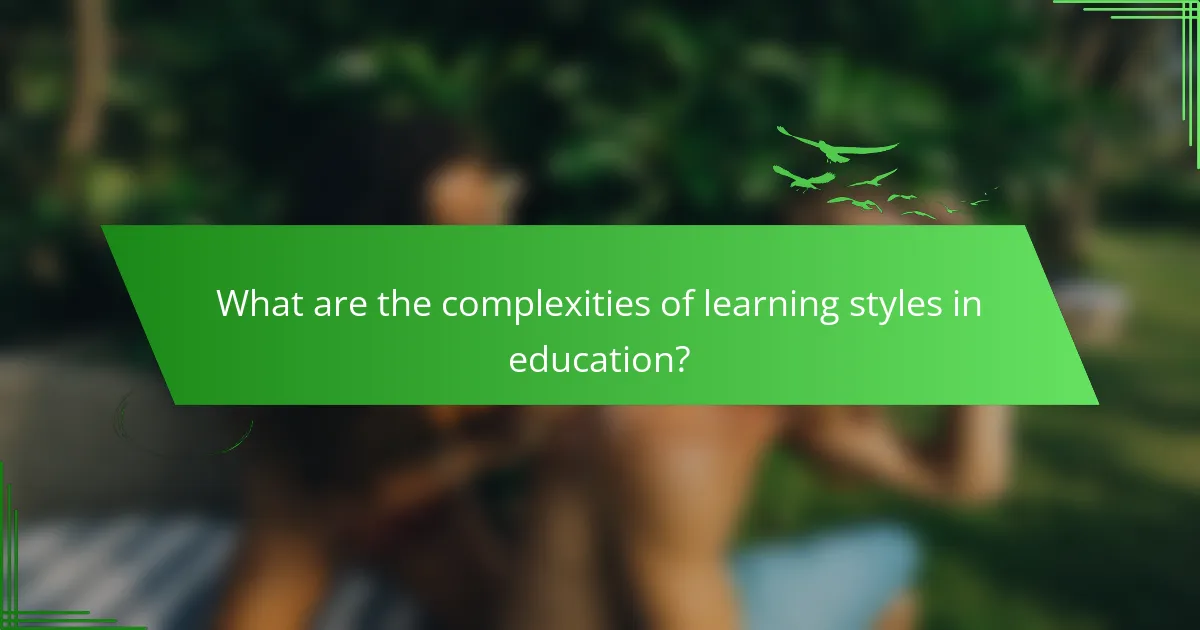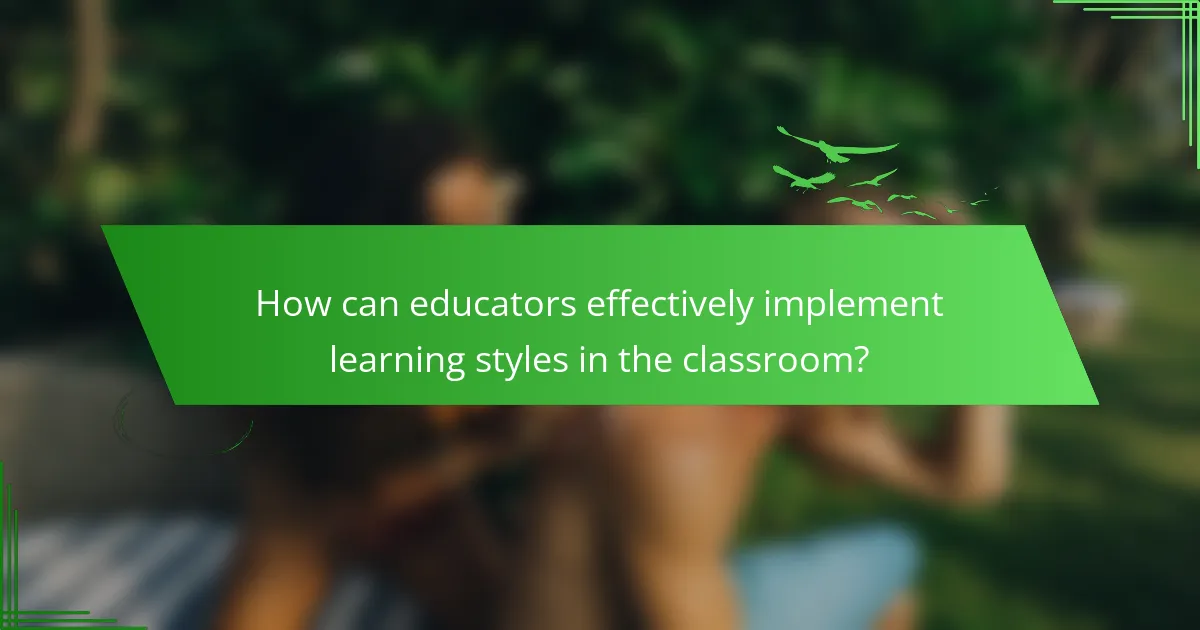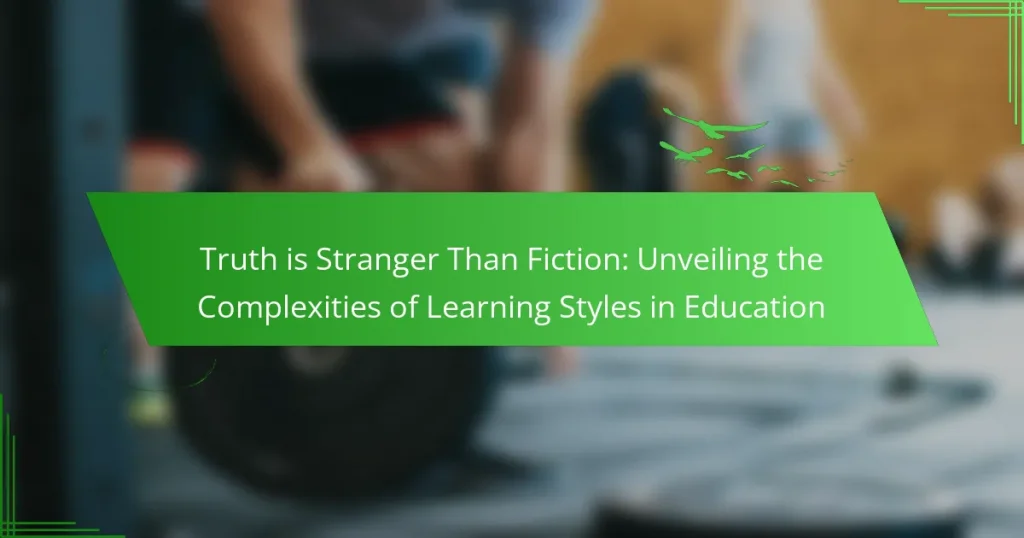Understanding the complexities of learning styles in education is crucial for enhancing student engagement and retention. Individual differences in cognition and perception, influenced by cultural background and personal experiences, shape how students learn. This article explores universal attributes affecting learning styles, distinguishes unique and rare attributes, and discusses effective instructional strategies like differentiated instruction and collaborative learning. Regular assessment of student progress will also be highlighted to ensure teaching methods align with evolving preferences.

What are the complexities of learning styles in education?
Learning styles in education are complex due to individual differences in cognition and perception. Factors such as cultural background, personal experiences, and cognitive abilities influence how students learn. Research indicates that while some students may thrive in visual learning environments, others may excel through auditory or kinesthetic methods. Understanding these complexities allows educators to tailor their approaches, enhancing engagement and retention. Additionally, the debate over the effectiveness of learning styles continues, as studies show mixed results regarding their impact on academic performance.
How do learning styles influence educational outcomes?
Learning styles significantly influence educational outcomes by shaping how students engage with and absorb information. Research indicates that tailoring teaching methods to individual learning styles can enhance comprehension and retention. For example, visual learners benefit from diagrams, while auditory learners thrive with lectures. Recognising these preferences can lead to improved academic performance, motivation, and student satisfaction. Additionally, a unique attribute of learning styles is their variability; not all learners fit neatly into one category, highlighting the need for flexible educational approaches.
What are the most common learning styles identified in educational psychology?
The most common learning styles identified in educational psychology are visual, auditory, and kinesthetic. Visual learners prefer images and diagrams, auditory learners benefit from listening, and kinesthetic learners engage through hands-on activities. Understanding these styles can enhance teaching effectiveness.
What are the characteristics of visual learners?
Visual learners typically prefer to engage with information through images, diagrams, and visual aids. They often exhibit characteristics such as strong spatial awareness, a preference for visual organisation of information, and enhanced recall of visually presented material. These learners may benefit from colour-coded notes, charts, and other graphic representations that help them process and retain information effectively. Their unique attribute is the ability to grasp complex concepts quickly when visual elements are present, making visual aids crucial in educational settings.
What defines auditory learners?
Auditory learners are individuals who best absorb information through listening. They excel in environments that engage their hearing, such as lectures and discussions. Key attributes include a preference for verbal instructions, strong listening skills, and the ability to recall information better when it is presented audibly. These learners often benefit from techniques like reading aloud or using audio recordings to reinforce their learning.
How do kinesthetic learners engage with material?
Kinesthetic learners engage with material through hands-on experiences and physical activities. They benefit from interactive learning methods like role-playing, simulations, and experiments. These learners often retain information better when they can manipulate objects or engage in movement. For example, using models or conducting experiments allows them to connect theory to practice, enhancing their understanding of complex concepts.

What universal attributes impact learning styles?
Universal attributes that impact learning styles include cognitive preferences, sensory modalities, and environmental factors. Cognitive preferences dictate how individuals process information, while sensory modalities encompass visual, auditory, and kinesthetic learning types. Environmental factors, such as lighting and noise levels, influence concentration and retention. Understanding these attributes can enhance educational strategies and improve learning outcomes.
How do cultural contexts shape learning preferences?
Cultural contexts significantly influence learning preferences by shaping values, communication styles, and approaches to education. For instance, collectivist cultures often emphasise collaborative learning, while individualistic cultures may prioritise personal achievement. These preferences affect engagement and retention in educational settings. Understanding these dynamics can enhance teaching methods and curriculum design, making learning more effective across diverse cultural backgrounds.
What role does motivation play in learning styles?
Motivation significantly influences learning styles by shaping how individuals engage with educational content. Intrinsic motivation enhances self-directed learning, while extrinsic motivation can drive participation in structured environments. Research indicates that motivated learners adapt their styles to optimise outcomes, demonstrating a unique attribute of motivation’s role in educational success. Understanding these dynamics allows educators to tailor approaches that foster engagement, ultimately improving learning effectiveness.

What unique attributes distinguish various learning styles?
Various learning styles are distinguished by unique attributes such as sensory preference, cognitive processing, and engagement level. Sensory preference includes visual, auditory, and kinesthetic modalities, impacting how information is absorbed. Cognitive processing varies from analytical to holistic approaches, influencing problem-solving methods. Engagement level reflects intrinsic versus extrinsic motivation, affecting participation and retention. Understanding these attributes helps tailor educational strategies to individual needs.
How do individual learning styles affect teaching methods?
Individual learning styles significantly influence teaching methods by shaping how educators design their lessons. Tailoring instruction to diverse styles enhances engagement and retention. For instance, visual learners benefit from diagrams, while auditory learners thrive with discussions. Acknowledging these differences allows teachers to implement varied strategies, such as collaborative projects for kinesthetic learners. Adapting methods to fit learning styles fosters a more inclusive educational environment, ultimately improving student outcomes.
What are the implications of multiple intelligences on learning styles?
The implications of multiple intelligences on learning styles highlight the need for personalised education approaches. Understanding diverse intelligences allows educators to tailor instruction methods, enhancing student engagement and retention. For instance, incorporating visual aids benefits those with strong spatial intelligence, while kinesthetic activities support bodily-kinesthetic learners. This differentiation fosters a more inclusive learning environment, addressing unique student needs and promoting overall academic success.

What rare attributes are associated with learning styles?
Rare attributes associated with learning styles include adaptability to diverse environments, cognitive flexibility, and emotional intelligence. These attributes enhance personalised learning experiences and engagement. Understanding these rare attributes can lead to more effective educational strategies.
How do emotional factors influence learning preferences?
Emotional factors significantly influence learning preferences by affecting motivation and engagement. For instance, positive emotions can enhance focus and retention, while negative emotions may hinder learning processes. Research shows that learners with high emotional intelligence adapt their styles more effectively, demonstrating a unique attribute of emotional awareness in educational settings. Additionally, emotional connections to content can lead to deeper understanding and retention, highlighting the rare attribute of emotional resonance in learning.
What is the significance of neurodiversity in learning styles?
Neurodiversity significantly enhances learning styles by recognising and valuing cognitive differences. This approach fosters inclusive education, tailoring methods to diverse needs. Research shows that embracing neurodiversity leads to improved engagement and academic performance. For example, students with dyslexia may excel in visual learning, while those with ADHD often thrive in interactive environments. By accommodating these variations, educators can create a more effective and supportive learning atmosphere.

How can educators effectively implement learning styles in the classroom?
Educators can effectively implement learning styles by tailoring instruction to diverse student needs. Understanding individual preferences enhances engagement and retention.
One effective strategy is differentiated instruction, which involves modifying content, process, and product based on students’ learning styles. For example, visual learners benefit from diagrams, while auditory learners thrive with discussions.
Additionally, incorporating collaborative learning allows students to share their strengths, fostering a supportive environment. This approach not only respects learning styles but also builds community in the classroom.
Regular assessment of student progress ensures that instructional methods remain aligned with evolving learning preferences, promoting continuous improvement in teaching effectiveness.
What strategies can teachers use to accommodate diverse learning styles?
Teachers can accommodate diverse learning styles by implementing differentiated instruction, using varied teaching materials, and fostering a supportive classroom environment. Differentiated instruction tailors teaching methods to meet individual student needs. For example, visual learners benefit from diagrams, while kinesthetic learners thrive through hands-on activities. Incorporating technology can also enhance engagement and cater to different preferences. Additionally, fostering a supportive environment encourages open communication, allowing students to express their learning needs. This approach acknowledges the unique attributes of each learner, promoting inclusivity and effective learning outcomes.
What common mistakes should educators avoid when addressing learning styles?
Educators should avoid several common mistakes when addressing learning styles. First, they should not oversimplify learning styles into rigid categories. This can lead to misinterpretation of student needs. Second, relying exclusively on one learning style can limit educational effectiveness. It’s essential to incorporate diverse teaching methods. Third, neglecting to assess students’ actual learning preferences can result in ineffective strategies. Regular feedback and assessment are crucial for adapting approaches. Lastly, ignoring the interplay between learning styles and other factors, such as motivation and environment, can undermine educational outcomes.
What best practices can enhance learning outcomes through tailored approaches?
Tailored approaches enhance learning outcomes by aligning teaching methods with individual learning styles. These practices include personalised instruction, adaptive technology, and varied assessment techniques. Personalised instruction allows educators to address unique student needs, while adaptive technology adjusts content delivery based on real-time feedback. Varied assessment techniques ensure that students demonstrate understanding in ways that suit their strengths, leading to improved engagement and retention.




